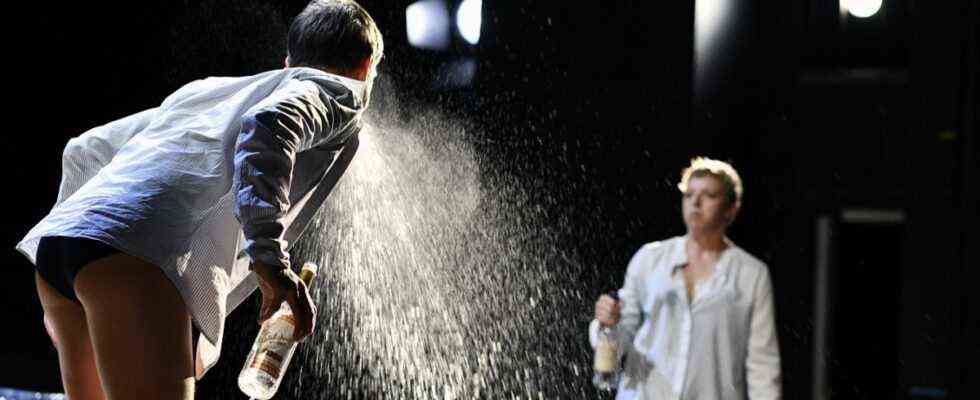The most spoken sentence in this performance does not come from Friedrich Dürrenmatt. It reads “this is what is left of Europe”, it is the recurring mantra of the sound performer Camilla Sparksss, it is outcry and accusation, the sound of the warning sign towards which the evening is increasingly uncompromising. Nicolas Stemann, who, together with Benjamin von Blomberg, is the director of the Schauspielhaus Zürich, stages Dürenmatt’s “Visit of the Old Lady” at the Pfauen; He made two attempts, twice the lockdown intervened. But now the premiere is just in time, in the year in which Dürrenmatt would have been 100 years old and 65 years after the premiere here in the same place.
Dürrenmatt is booming: in Basel they play “Die Physiker”
This year, of course, Dürrenmatt is booming, at the same time as Stemann’s production, “Die Physiker” will be released at the Basel Theater, as a re-enactment of the premiere, produced by the theater ensemble without a director, based only on the director’s book from 1962. Stemann’s approach can be pretty much the exact one Imagine the opposite of this endeavor, although he lets the play narrate carefully, deleting little, adding nothing except for the angry antics of Camilla Sparksss. For this he needs an actress and an actor, Patrycia Ziolkowska and Sebastian Rudolph, nothing more. Ten years ago he staged Goethe’s “Faust” with the two of them at the Salzburg Festival; In the first part of the eight-hour integral production, there were only three of them, Sparksss wasn’t there, but the actor Philipp Hochmair.
The stage is initially empty except for a plexiglass DJ desk, and Ziolkowska and Rudolph do not enter it either. You stand down in front of the audience, both black pants, white shirt, and begin to imagine the drama, take turns in the dialogues, create a scene with just words, create many characters. They flirt with the audience, play it directly, ensnare it, drag it into the story of Claire Zachanassian, who returns to her hometown Güllen after many years to take revenge on Ill, whom she once loved as much as he loved her. of which she became pregnant, whereupon he denied paternity, called false witnesses in court. Claire left the place, ended up in the brothel, met an Armenian billionaire there, had a series of successful marriages and is now immensely rich. The result: “With my financial strength you build a world order.”
Claire’s plan is perfidious and perfect. She has long since tracked down and emasculated the false witnesses from back then, had all of Güllen’s businesses bought up and rotten, the place is completely bankrupt, and now it offers a billion if its residents murder Ill.
That Claire once survived a crash in Afghanistan seems like a grotesque premonition from the author
Ziolkowska and Rudolph tell the plot very vividly, highly virtuoso, tenderly and loudly, but also with an ironically superior distance. Playing 35 pieces in pairs is no problem for her. But empathizing with just one of them is a problem for the viewer. The Ziolkowska-Rudolph show is the demonstration of grandiose skills, both develop special absurdity in the adaptation to Claire, the indestructible man held together by prostheses – she once survived a plane crash in Afghanistan, which from today’s point of view looks like a grotesque premonition from Dürrenmatt. And one scene is really oppressive, namely the one in which the teacher can no longer cope with the immorality surrounding him and wants to drink himself out of trouble in a desperate, self-destructive intoxication.
Stemann is less interested in the piece’s implicit moral discussions, but he distills a comprehensive accusation from it. At some point it seems only a matter of time for the residents of Güllens until Ill will be murdered, the only problem is, they have to do it themselves. Do them too. But first they buy on credit. At this point in time, Camilla Sparksss had already started up her sound machines several times and, in wild chanting, conjured the end of the humanity of which Europe is so proud. Now Ding-Dong does it, and one parcel after the other arrives on stage, 300 pairs of yellow shoes, videos fill the stage space, show pictures of demonstrations against luxury and “market collapse”, show the fall of the earth, conflagrations, floods, and maelstrom of doom. At the end, Sparksss tells the moral of the story, which ultimately amounts to the utopia of a fair world. Because what’s left of Europe? Just like Nicolas Stemann reads the 65-year-old text: nothing.

